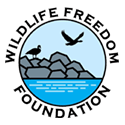Rehabilitating Wildlife
Every year the Wildlife Freedom Foundation comes to the aid of many injured, distressed or orphaned wild animals in need of immediate help. With the training, skills and devotion of our State & Federally licensed wildlife rehabilitator, hundreds of animals can be successfully rescued, rehabilitated and released back into the wild where they belong.
Wildlife rehabilitation is in no way an attempt to turn wild animals into pets. Injured wild animals are held in captivity only until they will be able to return to their independent life in the wild. Fear of humans is a necessary element for them and every effort is made to minimize human contact to prevent the domesticating/taming of the animals in need of rehabilitation. Wildlife rehabilitation is a complex and time-consuming process

Angel Wing
What is Angel Wing? In young birds wrapping the wing and binding it against the bird’s flank for a few days along with feeding the bird a more appropriate natural diet, can reverse the damage.
A diet that provides sufficient amounts of vitamin D (the “sunshine” vitamin), vitamin E and manganese may also be indicated.
Read more about: Angel Wing
Some of our work with wildlife includes reverting Angel wing in goslings:




Rehabilitating Migratory Birds
Watch the video: Releasing of 2 Warblers after rehabilitation
Rehabilitating The Gray Squirrel




The Opossum
The Virginia Opossum lives in many different habitats. Opossums are about the size of domestic cats. They generally have white heads with brown/black, coarse fur. The males are larger than the females and like most marsupials they are nocturnal, but they often forage during the day in the winter.
They have long, scaly, prehensile tails which help them to climb however, they cannot hang by their tails due to their size.
Virginia opossums are omnivorous, feeding on arthropods, fruit, leaves, carrion and rodents. Their 50 teeth help them eat this variety of food. The opossums breed twice a year, between January and February, and then in the summer in August. Their litters of 8 – 10 young are born two weeks after conception. They are carried in the pouch for up to 3 months, after which the babies will ride on their mother’s back for another 1 to 2 months. They become sexually mature at 6 months. Only the female rears the young as the Virginia opossum is a solitary species and only getting together for the breeding season. The female stays in her shelter range for life. The male has a semi-permanent home range, depending on the abundance of food.
Virginia opossums are placid animals but if threatened will hiss and even growl and bare their teeth. They also are able to produce a particularly unpleasant scent to ward off predators, such as owls, coyotes, dogs, and man. Because Opossums are slow-moving and easy prey, they tend to live for 1 to 2 years in the wild due to predation and/or collisions with motor vehicles. If kept in captivity they may live for up to 10 years.




